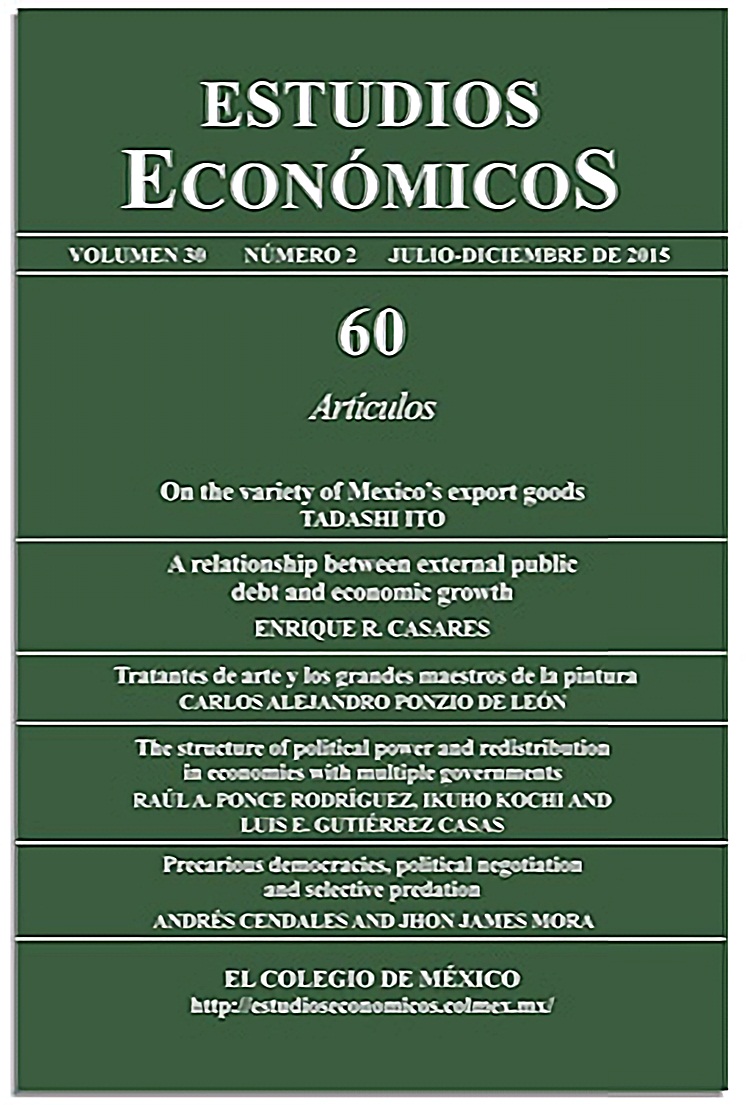Artículos
Publicado 2015-07-01
Palabras clave
- contratos,
- mercados de arte,
- grandes maestros de la pintura
Cómo citar
Ponzio de León, C. A. (2015). Tratantes de arte y los grandes maestros de la pintura. Estudios Económicos De El Colegio De México, 30(2), 245–268. https://doi.org/10.24201/ee.v30i2.28
Resumen
Se presenta un modelo sobre los contratos surgidos durante el Renacimiento entre pintores y los primeros tratantes de arte, así como las condiciones bajo las cuales el convenio de trabajo era ventajoso para ambos. El modelo explica por qué la relación funcionó adecuadamente para pintores menores y por qué los grandes maestros se mantuvieron al margen de dicha conexión. El modelo finalmente estudia la relación entre el número de pintores al servicio de un comerciante y los costos de mercadeo y promoción de la obra de arte.
Descargas
Los datos de descargas todavía no están disponibles.
Citas
- Aghion, Philippe y P. Howith. 1992. A model of growth through creative destruction, Econometrica, 60: 323-351.
- Cecchini, I. 2000. Quadri e comercio a Venezia durante il seicento: uno studio sul mercato dell’arte, Marsilio, Venecia.
- Coffin, J., R. Stacey, J. Cole y C. Symes. 2011. Western civilizations: Their history and their culture, W.W. Norton.
- De Marchi, N. y H. J. Van Miegroet. 2000a. Pricing invention: ‘Originals’, ‘copies’ and their relative value in seventeenth century Netherlandish art markets, en V. A. Ginsburgh y P. M. Menger (comps.), Economics of the arts, selected essays, Elsevier, Amsterdam, pp. 27-70.
- De Marchi, N. y H. J. Van Miegroet. 2000b. Exploringmarkets for Netherlandisch paintings in Spain and Nueva España, en R. Falkenburg, J. de Long, D. Meijers, B. Ramakers y M. Westermann (comps.), Kunst voor de markt/art for the market, 1500-1700, Netherlands Yearbook for the History of Art 1999, 50: 81-111.
- De Marchi, N. y H. J. Van Miegroet. 2006. The history of art markets, en V. A. Ginsburgh y D. Throsby (comps.) Handbook of the economics of art and culture, Elsevier, Amsterdam.
- Echeverría, I. 2000. Notas sobre el comercio artística entre Sevilla y América en 1586, Museo de América Annales, 8: 103-110.
- Falomir, M. 2006. Artists’ responses to the rise in demand for paintings in Spain, 1575-1625, en N. de Marchi y H. J. Van Miegroet (comps.), Mapping markets for paintings, Brepols, pp. 135-161.
- Gadol, J. 1969. Leon Battista Alberti, universal man of the early Renaissance, The University of Chicago Press, Chicago.
- Gelderblom, O. 2000. Zuid-Nederlandse Kooplieden en de opkomst van de Amsterdamse Stapelmarket (1578-1630), Verloren, Hilversum.
- Goldthwaite, R. A. 2003. Economic parameters of the Italian art market 15th to 17th centuries, en M. Fantoni, L. C. Matthew y S. F. Matthews-Grieco (comps.), The Art Market in Italy, Panini, Modena, pp. 423-444.
- Grossman, G. M. y E. Helpman. 1991. Innovation and growth in the global economy, MIT Press, Cambridge.
- Gozzano, N. 2003. Resa dei conti in Casa Colonna: Accounting from a roman collection, en F. Cappalletti (comp.) Decorazioni e collezionismo a Romanel Seicento, Libreria Universitaria, Roma, pp. 175-185.
- Gozzano, N. 2004. La quadreria di Lorenzo Onofrio Colonna, Builzoni, Roma.
- Haskell, F. 1980. Patrons and painters, art and society in baroque Italy, Yale University Press, New Haven.
- Kremer, M. 1993, Population growth and technological change: One million B. C. to 1990, Quarterly Journal of Economics, 108: 681-716.
- Lorizzo, L. 2003. Documenti inediti sul mercato dell’arte. I testament e l’inventario della bottega del Genovese Pellegrino Peri ‘rivenditori di quadriá Roma nella seconda met´a del Seicento, en F. Cappalletti (comp.) Deco- razioni e collezionismo a Roma nel Seicento, Libreria Universitaria, Roma, pp. 159-174.
- Lorizzo, L. 2006. People and practices in the paintings trade in 17th C. Rome, en N De Marchi y H. J. Van Miegroet (comps.), Mappings markets for paintings in Europe, 1450-1750, Brepols, pp. 343-358.
- Lynch, J. 1969. Spain under the Hapsburgs, Blackwell, Oxford. Montias, J. M. 1990. Estimates of the number of Dutch master-painters, their earnings and their output in 1650, Leidschrift, 6: 59-74.
- Palomero Páramo, J. M. 1998. Notas sobre el taller de Zurbarán, en Zurbarán IV centenario del nacimiento (catalogo y actas del simposium internacional Zurbarán y su época), Editora Regional de Extremadura, España, pp. 17-31.
- Quintana Echeverría, I. 2000. Notas sobre el comercio artística entre Sevilla y América en 1586, Anales del Museo de América, 8: 103-110.
- Romer, P. 1990. Endogenous technological change, Journal of Political Economy, 98: s71-s102.
- Shaw, J.E. 2006. Institutional controls and the retail in Venice, en N. De Marchi y H.J. Van Miegroet (comps.), Mappings markets for paintings in Europe, 1450-1750, Brepols, 107-122.
- Szanto, M. 2001. La stratégie de l`artium amatoris. Les banquiers Lumargue et le commerce des tableux, des fréres Goetkindt á Jean Valdro (1600-1660), en S. Cavaciocchi (comp.) Economia e arte, Le Monnier, Florencia, pp. 149-185.
- Torre Revello. 1948. Obras de arte enviadas al Nuevo Mundo en los siglos XVI y XVII, Anales del Instituto de Arte Americano e Investigaciones Estéticas, 1: 132-145.
- Van der Woude, A. 1991. The volumen and value of paintings in Holland at the time of the Dutch Republic, en D. Freedberg y J. De Vries (comps.) Art in history, history in art, Getty Center, Santa Monica, pp. 285-329.
- Vasari, Giorgio. 1996 [1568]. Vidas de grandes artistas, Porrúa, México.
- Welch, E. 2003. From retail to resale: Artistic value and the second-handmarket in Italy (1400-1550), en M. Fantoni, L. C. Matthew y S. F. Matthews-Grieco (comps.), The Art Market in Italy, Panini, Modena, pp. 283-299.

